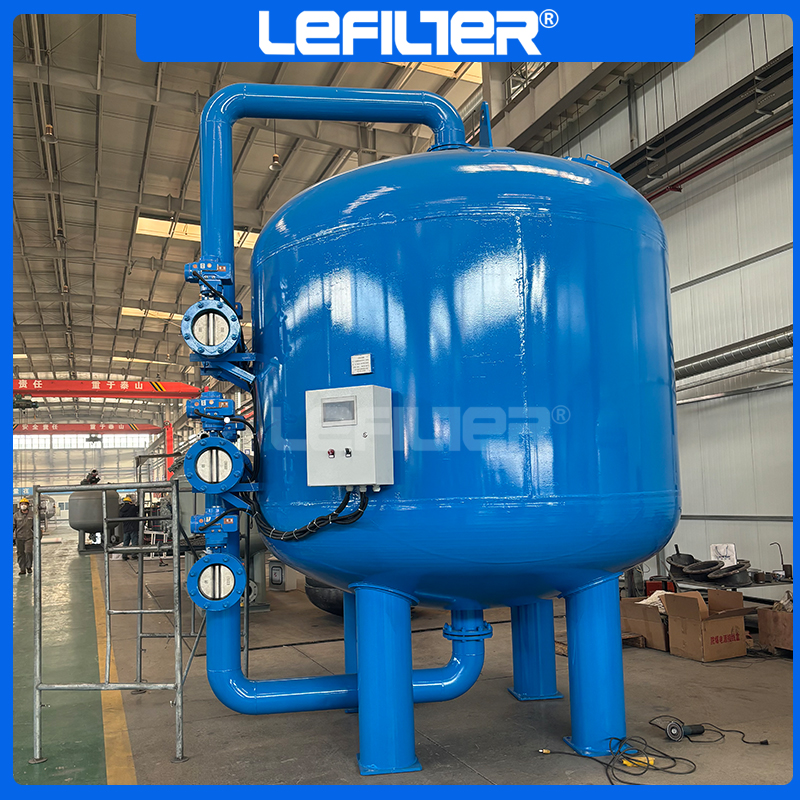Multimedia Filters in Wastewater Treatment for Refineries: Ensuring Compliance and Environmental Protection
DATE:2024-11-05 Number of views: 1 Source:dongwenhui
In the oil and gas industry, wastewater treatment is a critical aspect of refinery operations. Refineries generate substantial amounts of wastewater, which can contain harmful contaminants such as hydrocarbons, heavy metals, and other pollutants. The management and treatment of this wastewater are essential to comply with environmental regulations and to protect surrounding ecosystems. Multimedia filters play a significant role in refining wastewater treatment, ensuring that effluents meet regulatory standards before discharge. We explore the importance of multimedia filters in wastewater treatment for refineries, their operational mechanisms, and the environmental benefits they provide.
Understanding Wastewater in Refineries
Refinery wastewater is produced during various processes, including distillation, cooling, and equipment washing. This water often contains:
Hydrocarbons: Residues from crude oil and other processes can persist in wastewater, making it potentially harmful.
Heavy Metals: Elements such as lead, mercury, and cadmium can enter wastewater streams through equipment wear and chemical processes.
Suspended Solids: Particles from the production process can accumulate, increasing the turbidity of the wastewater.
Nutrients: Excess nitrogen and phosphorus from chemical treatments can lead to eutrophication in receiving waters.
Given these potential contaminants, refineries must implement effective treatment systems to ensure that wastewater discharged into the environment is safe and compliant with regulatory standards.

The Role of Multimedia Filters in Wastewater Treatment
Multimedia filters are engineered filtration systems composed of multiple layers of different filtration media. These layers may include sand, gravel, activated carbon, and other materials, each chosen for their specific filtration properties. The primary function of multimedia filters in wastewater treatment is to remove a broad spectrum of contaminants effectively.
How Multimedia Filters Work
Layered Filtration: Each layer of media targets specific contaminants. For example, coarse sand removes larger particles, while activated carbon adsorbs dissolved organic compounds and hydrocarbons.
Depth Filtration: Unlike single-layer filters, multimedia filters utilize the entire depth of the media bed. As wastewater flows through, contaminants are captured in multiple stages, enhancing overall filtration efficiency.
Backwashing Capability: Multimedia filters can be periodically cleaned through backwashing, where the flow is reversed to dislodge trapped particles. This process helps maintain optimal filtration performance and extends the life of the media.
Versatility: Multimedia filters can be adapted to treat various types of wastewater, making them suitable for different refinery processes.

Importance of Multimedia Filters in Meeting Regulatory Standards
Environmental regulations governing wastewater discharge are stringent, as unprocessed wastewater can pose significant risks to aquatic ecosystems and public health. Multimedia filters are integral in helping refineries meet these standards by:
1. Removing Hydrocarbons
Hydrocarbons present in refinery wastewater can be toxic to aquatic life. Multimedia filters, especially those equipped with activated carbon, effectively adsorb these compounds, reducing their concentration to acceptable levels.
2. Eliminating Heavy Metals
Heavy metals are persistent pollutants that can accumulate in the environment, causing long-term ecological damage. Multimedia filters can effectively remove these metals from wastewater, helping refineries comply with regulations regarding heavy metal discharge.
3. Reducing Suspended Solids
High levels of suspended solids can hinder aquatic life and degrade water quality. Multimedia filters can significantly reduce turbidity by removing particulate matter, ensuring that the treated water is clear and safe for discharge.
4. Enhancing Nutrient Removal
Excessive nutrients can lead to algal blooms, depleting oxygen levels and harming aquatic ecosystems. Multimedia filters can be configured to address nutrient loads effectively, contributing to healthier water bodies.
Environmental Benefits of Multimedia Filtration
The implementation of multimedia filters in refinery wastewater treatment offers numerous environmental advantages, including:
1. Ecosystem Protection
By removing harmful contaminants from wastewater, multimedia filters help safeguard local ecosystems from pollution, preserving biodiversity and promoting healthier water quality.
2. Compliance with Environmental Regulations
Meeting regulatory standards is not only a legal requirement but also a moral responsibility. Multimedia filters enable refineries to achieve compliance, thereby reducing the risk of fines and enhancing their corporate social responsibility profiles.
3. Resource Recovery
Some multimedia filtration systems can be designed to recover valuable resources from wastewater, such as water for reuse in refinery operations or recovering certain materials for further processing, contributing to a more sustainable operational model.
4. Supporting Sustainable Practices
Effective wastewater treatment through multimedia filters aligns with broader sustainability goals within the oil and gas industry. By minimizing waste and reducing environmental impact, refineries can contribute to a more sustainable future.

Conclusion
Multimedia filters play an essential role in the wastewater treatment processes of refineries. By efficiently removing hydrocarbons, heavy metals, and other contaminants, they help ensure compliance with environmental regulations while protecting ecosystems. As the oil and gas industry continues to face scrutiny regarding its environmental impact, the implementation of advanced filtration technologies like multimedia filters will be vital for promoting sustainability and operational efficiency.
FAQ
What are multimedia filters?
Multimedia filters are filtration systems that use multiple layers of different media to remove contaminants from wastewater effectively.
How do multimedia filters help with regulatory compliance?
They remove harmful substances such as hydrocarbons and heavy metals, ensuring that discharged wastewater meets environmental standards.
What types of contaminants can multimedia filters remove?
They can effectively remove hydrocarbons, heavy metals, suspended solids, and excess nutrients from wastewater.
How often do multimedia filters require maintenance?
Maintenance includes regular backwashing to clean the media and periodic replacement of filter media, depending on the level of contaminants.
Can multimedia filters be used for other types of wastewater?
Yes, multimedia filters can be adapted for various wastewater types, making them versatile for different industrial applications.
What is the environmental impact of using multimedia filters?
They help protect ecosystems by reducing pollution levels in discharged wastewater, promoting healthier aquatic environments.
Are multimedia filters cost-effective for refineries?
While initial setup costs can be high, the long-term savings from reduced regulatory fines and maintenance costs make them a cost-effective choice.
How do multimedia filters enhance resource recovery?
They can enable the reuse of treated wastewater for other refinery processes, contributing to more sustainable operations.
Related Products


